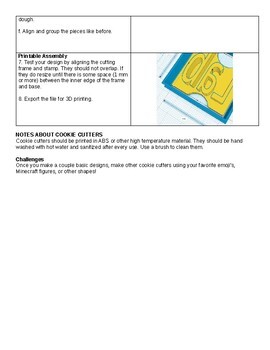TinkerCAD Cookie Cutter Activity
3D-PT
125 Followers
Grade Levels
6th - 12th, Higher Education, Adult Education, Homeschool, Staff
Resource Type
Standards
CCSS5.OA.B.3
CCSS5.G.A.1
CCSS5.G.A.2
CCSS5.G.B.3
CCSS5.G.B.4
Formats Included
- PDF
- Easel Activity
- Easel Assessment
Pages
4 pages
3D-PT
125 Followers
Easel Activity Included
This resource includes a ready-to-use interactive activity students can complete on any device. Easel by TPT is free to use! Learn more.
Easel Assessment Included
This resource includes a self-grading quiz students can complete on any device. Easel by TPT is free to use! Learn more.
Also included in
- Empower your students with the fascinating world of 3D printing through our comprehensive "TinkerCAD 3D Printing Lesson Bundle." This resource is your all-in-one solution for introducing 3D design, creativity, and innovation into your classroom.Key Highlights: Comprehensive Curriculum: Our bundle ofPrice $113.54Original Price $162.20Save $48.66
Description
Elevate your classroom with the "TinkerCAD Cookie Cutter Activity." This engaging resource combines the world of 3D design with the sweet satisfaction of baking, offering a hands-on and delicious approach to learning.
Highlights:
- Edible Engineering: Students dive into the exciting world of 3D design as they create their very own custom cookie cutters. It's a delightful blend of art and engineering that sparks creativity.
- Practical Application: Beyond the computer screen, this activity culminates in the production of real, usable cookie cutters. Taste the sweet success of a hands-on lesson.
- STEAM Integration: Seamlessly integrate Science, Technology, Engineering, Art, and Mathematics (STEAM) principles into your classroom. It's an interactive and multidisciplinary learning experience.
- Easy-to-Follow Instructions: Enjoy step-by-step instructions that guide you through the entire process, making it accessible for both educators and students, regardless of their tech-savviness.
- Customization and Creativity: Encourage students to let their imaginations run wild as they design unique cookie cutters. It's a project that celebrates individuality and innovation.
- Real-World Skills: Equip your students with valuable skills in 3D design and digital fabrication, all while having a blast in the process.
- Tasty Rewards: The final product? Delicious cookies in fun and personalized shapes. It's a memorable way to enjoy the fruits of their labor.
Turn your classroom into a hub of edible engineering with the "TinkerCAD Cookie Cutter Activity." Download now and let the creativity and cookies flow!
You should print any cookie cutter in ABS, PC, PETG or other high temperature material so they can withstand hot water.
Total Pages
4 pages
Answer Key
N/A
Teaching Duration
2 hours
Report this resource to TPT
Reported resources will be reviewed by our team. Report this resource to let us know if this resource violates TPT’s content guidelines.
Standards
to see state-specific standards (only available in the US).
CCSS5.OA.B.3
Generate two numerical patterns using two given rules. Identify apparent relationships between corresponding terms. Form ordered pairs consisting of corresponding terms from the two patterns, and graph the ordered pairs on a coordinate plane. For example, given the rule “Add 3” and the starting number 0, and given the rule “Add 6” and the starting number 0, generate terms in the resulting sequences, and observe that the terms in one sequence are twice the corresponding terms in the other sequence. Explain informally why this is so.
CCSS5.G.A.1
Use a pair of perpendicular number lines, called axes, to define a coordinate system, with the intersection of the lines (the origin) arranged to coincide with the 0 on each line and a given point in the plane located by using an ordered pair of numbers, called its coordinates. Understand that the first number indicates how far to travel from the origin in the direction of one axis, and the second number indicates how far to travel in the direction of the second axis, with the convention that the names of the two axes and the coordinates correspond (e.g., 𝘹-axis and 𝘹-coordinate, 𝘺-axis and 𝘺-coordinate).
CCSS5.G.A.2
Represent real world and mathematical problems by graphing points in the first quadrant of the coordinate plane, and interpret coordinate values of points in the context of the situation.
CCSS5.G.B.3
Understand that attributes belonging to a category of two-dimensional figures also belong to all subcategories of that category. For example, all rectangles have four right angles and squares are rectangles, so all squares have four right angles.
CCSS5.G.B.4
Classify two-dimensional figures in a hierarchy based on properties.







